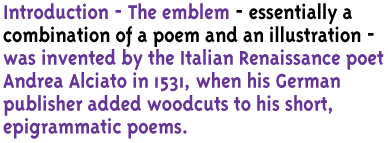


In the sixteenth and seventeenth centuries, emblems were generally made up of three components: a title or motto (referred to by the Latin term inscriptio), an illustration (pictura) and an explanatory text in prose or, more often, in verse (subscriptio). The attractive combination of texts and images meant the emblematic genre quickly became extremely popular in Italy and France.
Although this emblematic concept was a literary product of sixteenth-century Europe, popular medieval symbols and allegories, heraldic devices and hieroglyphs were used and re-used by emblematists. True to the ideals of the Renaissance, myths and legends from ancient Greek and Roman literature influenced the emblem genre in a significant way, as did Biblical and Christian motifs.
##When emblems were introduced to the Low Countries in the 1550s, most of the subscriptions were written in Latin, as almost all literature was at the time. In the 1570s and 1580s, an increasing number of poets called for the writing of literature in the vernacular. In 1601, DaniŽl Heinsius published the first emblem book with subscriptions in Dutch, and other prominent poets such as Hooft and Vondel soon followed his example. Roemer Visscher, himself a strong advocate of the use of the Dutch language, explicitly stated his love for his mother tongue in the >preface to his emblem book.
The first decades of the seventeenth century formed the zenith of emblem literature in the Dutch Republic. Nowhere else was the genre to flourish as richly as in the (Northern) Netherlands. Love emblematics became a Dutch speciality - Hooft`s Emblemata Amatoria (1611) being the outstanding example of its kind. In an even more characteristically Dutch type of emblem, the pictura and subscriptio referred directly to daily life, resulting in highly recognizable and therefore extremely popular emblem books. These emblems were the perfect vehicle for moralistic lessons, as can be observed in both Roemer Visscher`s Sinnepoppen and #Jacob Cats` Sinne- en Minnebeelden (1627), perhaps the most important emblem book of the Dutch Golden Age.

